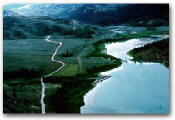Mountology
"Mountology" The psychology of mountain flying
|
"I know you believe you understand what you think I said, but I'm not sure you realize that what you heard is not what I meant." |
This gobbledygook, adopted by the FAA more than 20 years ago for flight instructor clinics was their attempt to demonstrate and reinforce the importance of communication.
'Mountology' is my fancifully contrived word used to describe the following proposal. Without careful study this plan may appear to contain the same double talk and confusion as the above FAA statement. Observant contemplation will prove it is not profuse verbiage or redundancy, but rather, it will ensure greater safety in all mountain flying operations.
Conditioned in psychology means exhibiting or trained to exhibit conditioned reflex or response. Reflex means an unlearned or instinctive response to a stimulus. Instinct means an innate aspect of behavior that is unlearned, complex and normally adaptive.
It is necessary to define some terms before trying to persuade you to train yourself to react in mountain flying situations like one of Pavlov's dogs. These terms are conditioned, reflex and instinct.
An instinctive response to a stimulus does not work at all times in an airplane. For example, when an airplane is in a spin, your instinct is to pull back on the control wheel to raise the nose. You have been taught that then the nose is down, you pull back. It has worked before, but not it is not adaptive. In a spin situation you must be trained to break the stall before pulling back on the control wheel. This training is a conditioned response.
True mountain flying—that is, terrain, contour or drainage flying, as opposed to flying well above the mountains—can be done with total safety only when the pilot becomes conditioned to apply the basic premised during flight, without having to think about them.
 |
BASIC PREMISE #1 |
Always remain in a position where you
can turn toward lowering terrain.
This axiom also encompasses the idea that you will not enter or fly in a canyon where there is not sufficient room to turn around. Another way of stating this truth is to have an escape route in mind and be in a position to exercise this option. |
 |
BASIC PREMISE #2 |
Do not fly beyond the point of no
return.
This is the position when flying upslope terrain where, if you reduce the throttle to idle and begin a normal glide, you will have sufficient altitude to turn around without impacting the terrain. Flying beyond this point drives home the southern sheriff's warning, "You're in a heap of trouble, boy." Constantly evaluate where you are and decide if you can lose altitude before having to turn the airplane. If not, you are narrowing your options substantially. |
What happens when the pilot flies beyond the point of no return? First, and usually the less serious consequence, involves landing the airplane straight ahead into whatever terrain exists. This normally results in destruction of the aircraft, but with proper technique the occupants will survive. Proper technique means the airspeed is maintained to allow transition to a normal landing attitude (often upslope terrain) without stalling the airplane.
The second outcome of
flying beyond the point of no return involves the stall-spin
accident. Because there is insufficient altitude or maneuvering
space to complete the turn around, the pilot may try to hurry the
turn with excessive bottom rudder, thus yawing the airplane. This
induces a stall-spin.
|
The Grand Teton, Jackson, Wyoming |
These aphorisms or basic premises of mountain flying are not instinctive. They must be conditioned responses. As an example, consider that at some point in your basic flight training your instructor began constantly challenging you to find an emergency landing site. After pulling the power off, he would say some like, "Your engine just failed, proceed as you would during an actual emergency. |
Soon you became conditioned so that when the instructor pulled the power, you already had a suitable landing area picked out and you headed for it, even though you might have been oblivious to your surroundings just before the simulated power failure.
This type training unconsciously caused you to seek an emergency area each time you were with the instructor. Eventually this training transfers to encompass all the time you are flying. Although you do not need an instructor (Pavlov) to condition you for mountain flying, it helps when you first begin mountain flying.
It is necessary for you to constantly think about the axioms of flight until you become conditioned to unconsciously remain in a position where you can turn toward lowering terrain and never fly beyond the point of no return.
|
|
|



